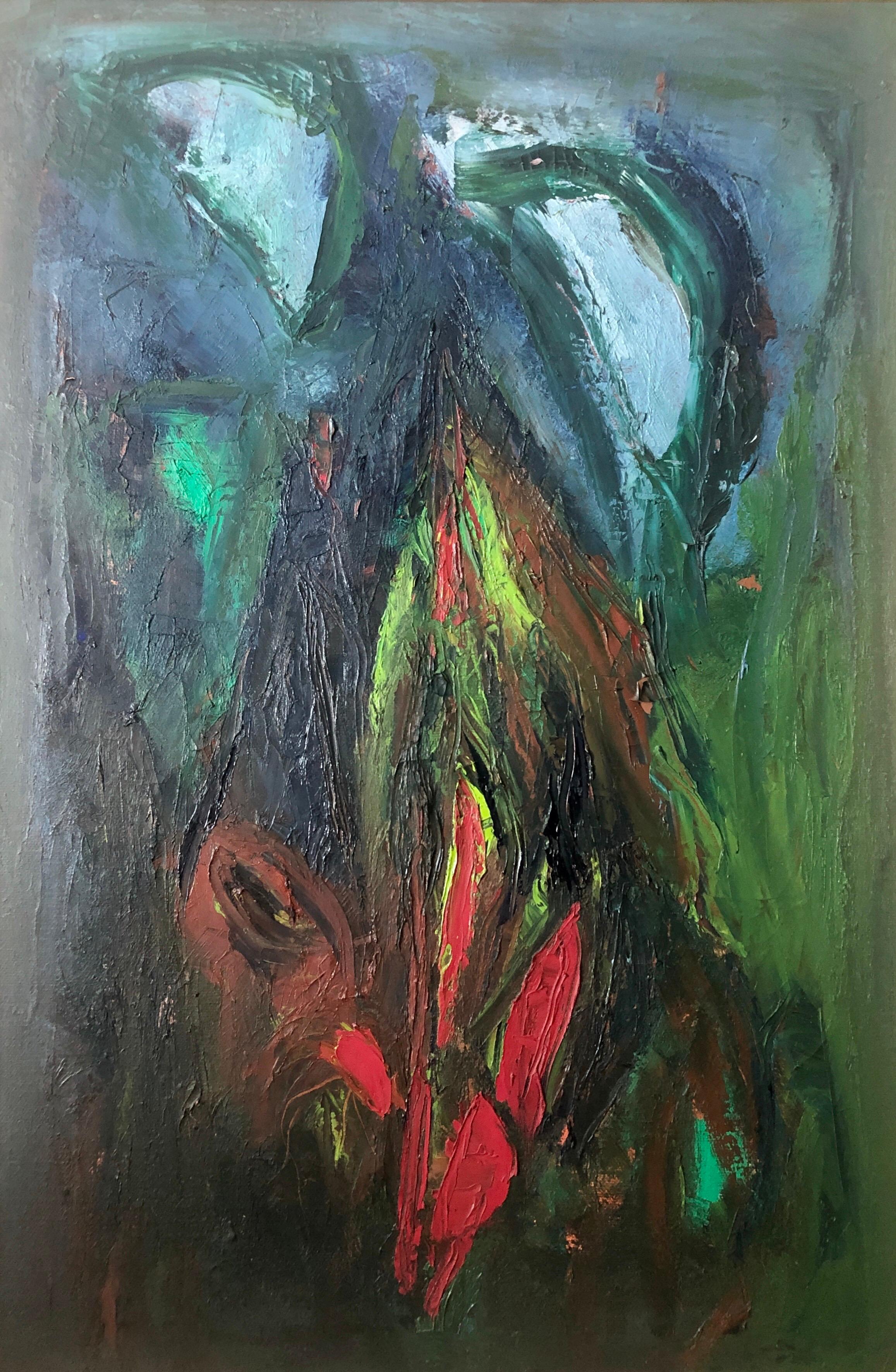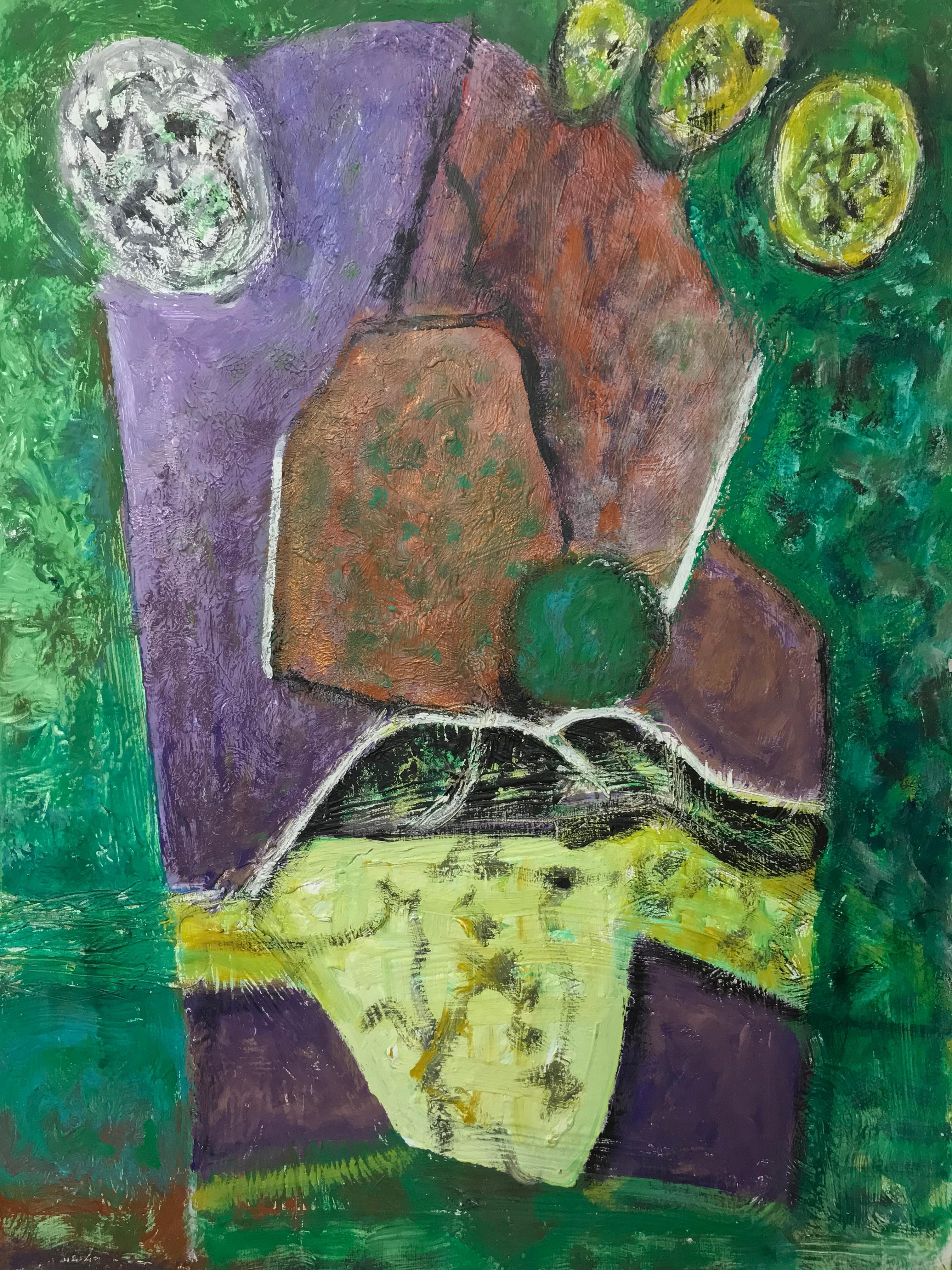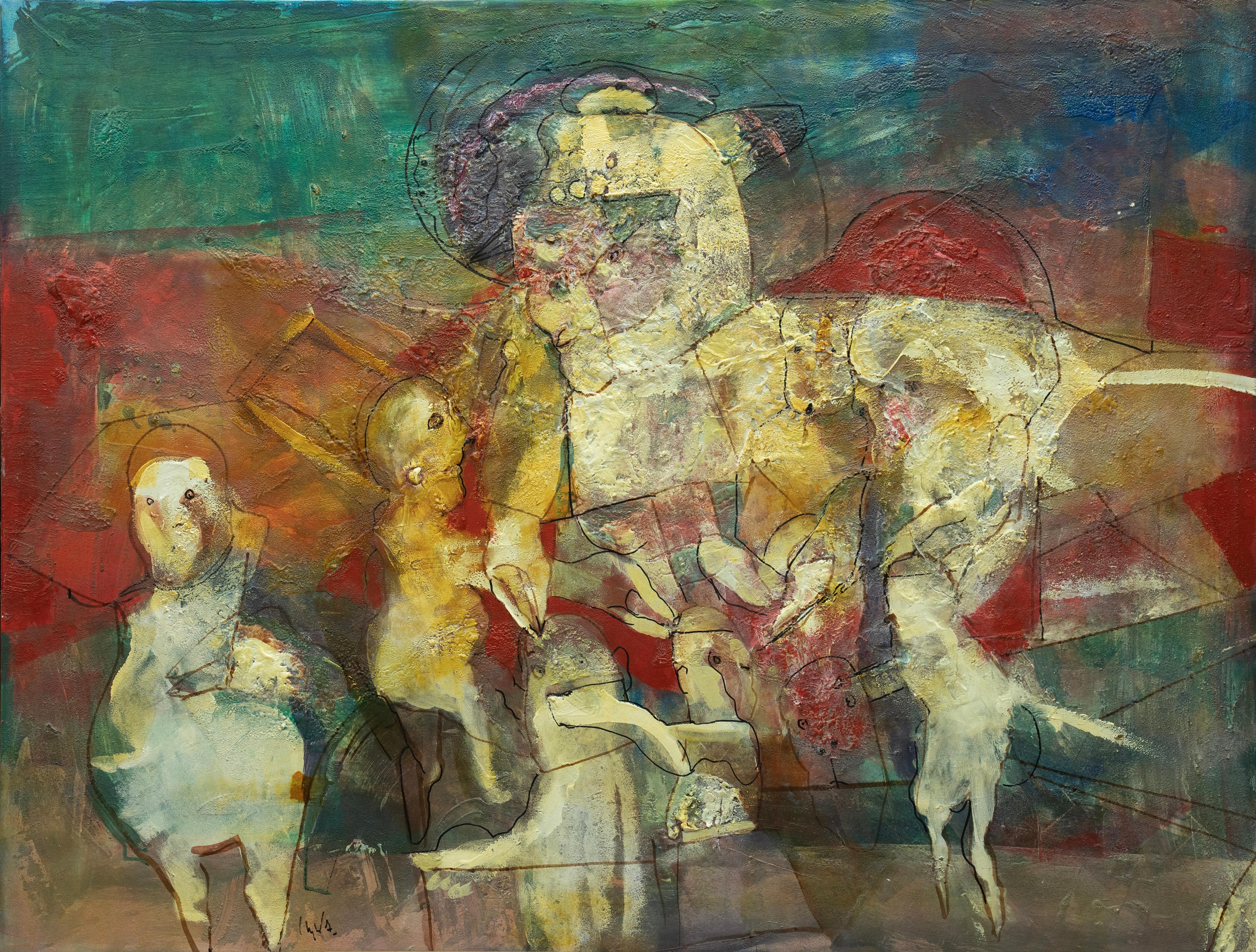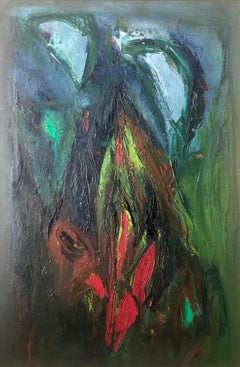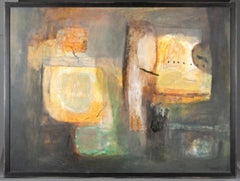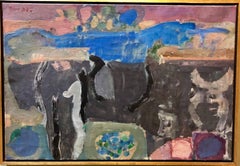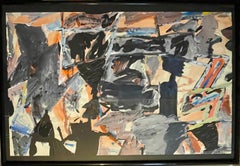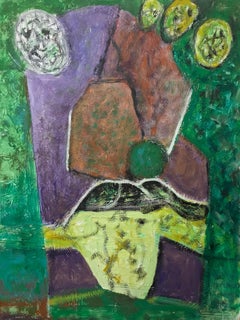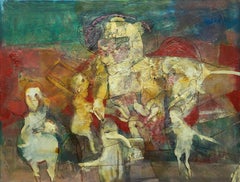Items Similar to Jewish Mexican Avant Garde Fiesta of Guadalupe Expressionist Oil Painting
Want more images or videos?
Request additional images or videos from the seller
1 of 15
Yonia FainJewish Mexican Avant Garde Fiesta of Guadalupe Expressionist Oil Paintingc.1940's
c.1940's
$12,000
£9,048.03
€10,465.37
CA$16,977.52
A$18,509.21
CHF 9,779.91
MX$227,619.68
NOK 121,605.27
SEK 114,475.25
DKK 78,125.90
About the Item
Genre: Avant-Garde
Subject: Abstract Mexican Landscape
Medium: Oil
Surface: Canvas
Country: Mexico
Dimensions:
Yonia Fain
Oil, 1947
Although this oil painting’s subject is predominantly abstract, there is a faint echo of a figural shape at its center. A figure wearing Tefillin, An organic form appears to be pinned to a hammer shaped object, reminiscent of a crucifix. This tool may be a reference to one of the Soviet Union’s symbols. Moreover, it is likely a direct reference to the persecution Fain faced as a Russian Jew in Bolshevik Russia. The contrast between colors, geometric lines, and organic curves is indicative of Fain’s collaboration with Diego Rivera, as well as the time he spent in Mexico. The primary hues communicate the hardship the artist underwent and his cathartic ability to reproduce those emotions through paint.
In addition to being a renowned artist and award-winning poet, Yonia Fain is among the few survivors to triumph over the turmoil of the 20th century. Fain’s abundant body of artwork and poetry pays tribute to the hardship many experienced during the Russian Revolution, Nazi invasion of Poland, and World War II. The persecution Fain experienced forced him to immigrate to several countries including China, Mexico, and the United States.
Yonia Fain was born in Russia in 1914. When he was only 10-years-old, he and his family fled from the Bolshevik Revolution to Poland. There he pursued his studies at the Academy of Fine Arts and hoped to continue his education in Paris. He was awarded B.A. and M.F.A. degrees from the University of Poland. In 1939, the artist and his wife Helen moved to Warsaw when the town they lived in, Vilna, became occupied by the Soviet Union. Although they managed to escape the Nazi Holocaust, Fain was apprehended by Soviet military and incarcerated. After he and his wife were released into Russia, they procured Japanese transit visas. Before the the bombing of Pearl Harbor, the Japanese shipped his family to a ghetto for Polish Jewish refugees in Shanghai, China. Throughout the remaining war years, Fain earned a living by painting individual portraits of Chinese militia and officials.
The tumultuous years of the war left Yonia Fain with no desire to return to Europe. In 1946, a friend of Fain sent samples of his art to the established Mexican artist, Diego Rivera. The muralist was so affected by Fain’s pieces that he sponsored a visa for the Fain family to Mexico. While there, Fain collaborated with Diego Rivera, learning the politics and skill of mural painting. During his years in Mexico, he had several exhibitions. All the while, Rivera encouraged Fain’s artistic merit and development by writing essays for his exhibition catalogs.
His stay in Mexico came to a close when artist Rufino Tamayo urged him to move to New York and recommended him for an art instructor position at the Brooklyn Museum. In addition to painting and exhibiting his work in the New York galleries of the day, he taught at New York University from 1964 until 1970. That same year, Fain was invited by the faculty of Hofstra University to teach the history and philosophy of art where he remained for over a decade.
Throughout his life, Fain has had several solo shows and his body of art has been included in exhibitions at the Whitney Museum of American Art, Butler Institute of American Art, Albright-Knox Gallery, Chrysler Art Museum, London Jewish Cultural Centre, and at the Carnegie International. Moreover, Fain is an award–winning Yiddish poet who has won international recognition with his books A Gallow Under the Stars, Beloved Strangers, New York Addresses, and The Fifth Season. Well into his nineties, Yonia Fain continued to create art shaped by his travels and struggles. The artist believed there was a reason for his survival and that through his work he was able to chronicle the calamities he witnessed. Fain’s paintings, drawings, and poems seek to honor the many who perished and who were unable to inspire or teach future generations.
- Creator:Yonia Fain (Mexican)
- Creation Year:c.1940's
- Dimensions:Height: 34 in (86.36 cm)Width: 42 in (106.68 cm)
- Medium:
- Movement & Style:
- Period:
- Condition:minor wear. it is in original untouched condition.
- Gallery Location:Surfside, FL
- Reference Number:1stDibs: LU38214793682
About the Seller
4.9
Platinum Seller
Premium sellers with a 4.7+ rating and 24-hour response times
Established in 1995
1stDibs seller since 2014
1,806 sales on 1stDibs
Typical response time: <1 hour
- ShippingRetrieving quote...Shipping from: Surfside, FL
- Return Policy
Authenticity Guarantee
In the unlikely event there’s an issue with an item’s authenticity, contact us within 1 year for a full refund. DetailsMoney-Back Guarantee
If your item is not as described, is damaged in transit, or does not arrive, contact us within 7 days for a full refund. Details24-Hour Cancellation
You have a 24-hour grace period in which to reconsider your purchase, with no questions asked.Vetted Professional Sellers
Our world-class sellers must adhere to strict standards for service and quality, maintaining the integrity of our listings.Price-Match Guarantee
If you find that a seller listed the same item for a lower price elsewhere, we’ll match it.Trusted Global Delivery
Our best-in-class carrier network provides specialized shipping options worldwide, including custom delivery.More From This Seller
View AllLarge Colorful MCM Abstract Expressionist Oil Painting Modernist Ralph Rosenborg
By Ralph Rosenborg
Located in Surfside, FL
Ralph Rosenborg (American, 1913-1992) Mountain Weed with Two Clouds, oil on jute canvas, canvas is hand signed recto and verso, artists label and Snyder Fine Art gallery label, The p...
Category
1960s Abstract Expressionist Abstract Paintings
Materials
Canvas, Jute, Oil
Large Rigoberto Mena Contemporary Cuban Abstract Expressionist Oil Painting
By Rigoberto Mena
Located in Surfside, FL
"Yellow/Green"
2004. Oil/Acrylic on Canvas. Signed lower right
Image: 34.5" x 47". Framed: 49" x 37".
Rigoberto Mena Santana (Cuban, born 1961) was born in Artemisia, Havana in 1961, where he currently lives and works. He attended the Instituto Politecnico de Diseno Industrial, La Habana, and continued his studies at San Alejandro Fine Art Academy, Havana. He traveled extensively throughout Europe to study the great masters. Mena has had Solo Exhibitions in China, Germany, Netherlands, Mexico, Cuba, Spain, France, and Holland, and in the U.S. in Miami, Massachusetts, Washington, D.C, and California. Following the inauguration of his exhibition “Hablando en Lenguas”. In 2011, Rigoberto’s work was chosen to be a part of the permanent collection of the National Museum of Fine Art in Havana, Cuba. Through the eyes of an abstract expressionist, he draws inspiration from his home’s urban landscapes and the spirit of the people and the city. The start of the Cuban Abstract movement was through a group called Los Once or The eleven. Though Mena was not an original member the influence by this new outlet began to spread ideals that put his own practice into fashion. Rigoberto is considered an important painter of his generation. He is one of the few artists in Cuba who has to have a private art gallery. Mena's private gallery at the Plaza de Armas is adjacent to the neighboring government art gallery. His work has been exhibited in Mexico, Belgium, Germany, France, Spain, and Holland.
Contemporaneous with the controversial, "La Generacion de los 80s" - The 80s Generation of Contemporary Cuban Art also referred to as New Cuban Art. This new Cuban plastic arts movement, with an expression of conceptual and non specific conscience manifestation, addressed many burning issues of the time and unveiled what these artists felt was the true reality of Cuba. It was more than a moment of artistic inspiration; it was a reflection of critical self-awareness and the new social role of art - the fundamental essence of the movement. They included Rubén Torres Llorca, Jose Bedia Valdes, Ricardo Rodriguez Brey, Juan Francisco Elso, Rogelio López Marín (Gory), Gustavo Pérez Monzón, José Manuel Fors, Leandro Soto Ortiz, Israel León, Tomás Sánchez and Carlos Alfonzo. In the second half of the decade, other artistic groups were formed, including 4 x 4, Grupo Hexágono, Arte Calle, Grupo Provisional, the duet René Francisco Rodríguez and Eduardo Ponjuán González and ABTV. Grupo Puré, another new wave of young artists, graduates of the Instituto Superior de Arte (ISA) included Ana Albertina Delgado Álvarez, Adriano Buergo, Ciro Quintana, Ermi Taño and Lázaro Saavedra, all greatly influenced by the German Kitsch art movement. Additionally, a large number of talented creators excelled independently, such as Florencio Gelabert (sculptor), Arturo Cuenca Sigarreta, Rigoberto Mena, Humberto Castro, Gustavo Acosta, Kcho, Antonio Eligio Fernandez (Tonel), Adriano Buergo, Flavio Garciandía, Tania Bruguera, Juan Francisco Elso, Carlos Rodríguez Cárdenas, Quisqueya Henríquez, Glexis Novoa, José Toirac, Carlos García, Heriberto Mora, Segundo Planes and Pedro Vizcaíno, among others.
Select Personal Exhibitions
2015 RBK 4200 ,La Cabaña,fortress. Bienal de La Habana,
2014 The shape without shape. Visual Arts Development Center, Bayamo, Cuba
2013 Allegro Ma Non Troppo. Lloyd’s Register, Havana.
2012 Spirit. Dennis Rosenthal Gallery, Chicago, U.S.A.
2011 Speaking in languages. Fine Arts National Museum, Havana.
2010 The places of time (with Alan Kleinmann). Orígenes Gallery, Havana’s Great Theater.
2009 The writing and the limit. 23 y 12 Gallery, Havana.
2007 The pleasure of absorb yourself. RAC Gallery, Veracruzan University, Xalapa, México.
2006 Coexistence. Public space, during the Ninth Havana’s Biennale.
2005 Ball change. La Casona Gallery, Havana, Cuba
Das Unbestimmbare Selbst. Refugium Gallery, Berlin.
2004 From the nothing to the infinite. La Casona Gallery, Havana, Cuba
2003 The visual poetry of life. Refugium Gallery, Berlin.
Rigoberto Mena. Recent Work. Habana Gallery, México DF.
Recent graphic work (with Jo Ann Rothschild). Graphic workshop, Havana.
Rigoberto Mena. Recent Work, Boston Art Institute, Lesley Boston University,
2001 Two plus one doesn’t make three (with Julio Girona and Angel Rivero), L Gallery,
2000 Cuba I, Space 12 Gallery, Boston, Massachusetts, United States.
Three abstract painters (with Jo Ann Rothschild and Julia Valdes...
Category
20th Century Abstract Expressionist Abstract Paintings
Materials
Canvas, Oil, Acrylic
Lyrical Abstract Israeli Expressionist Oil Painting
By Hanna Ben Dov
Located in Surfside, FL
Hanna Ben Dov is an Israeli abstract painter who was born in Jerusalem in 1919 and died in Paris in 2008.
Ben Dov's father, Yacov Ben-Dov, was a famous Israeli photographer who founded the photography department in the Bezalel Academy of Art and Design in 1910. Hannah herself attended Bezalel during the 1940s, and later continued to Camberwell College of Arts in London. After the completion of her formal education she moved to Paris, where she exhibited for the first time in 1948 and has been living and working there since, as a part of the local abstract artists school. She took part in the first French Biennale of 1951, that was held in Menton.
Collections
Her paintings can be found in several collections, including the French State Collection, the Tel Aviv Museum of Art collection, the Bezalel National Museum collection in Jerusalem and the Rockefeller Museum collection in New York.
Ben Dov resided for her last two years at the Maison Des Artistes Home in Nogent-Sur-Marne, France, just outside Paris.
Exhibitions
Gallery97 Tel Aviv Paintings...
Category
20th Century Modern Landscape Paintings
Materials
Canvas, Oil
Large Harry Bertschmann Swiss American Abstract Expressionist Outsider Painting
By Harry Bertschmann
Located in Surfside, FL
Harry Bertschmann (Swiss American, born 1931).
Acrylic painting on paper.
Artist signature to lower right.
Provenance: Joy Moos Gallery (this was exhibited at the Outsider Art Fair)
...
Category
20th Century Abstract Expressionist Abstract Paintings
Materials
Paper, Acrylic
Signed Castro Abstract Expressionist 1960s Latin American Oil Painting Collage
Located in Surfside, FL
'La Multitud Sodomita Rodea la Casa de Lot'
Titled and signed in Spanish. it refers to the biblical story of Lot with the Sodomites. It is a very well executed piece signed Castro an...
Category
1960s Abstract Expressionist Abstract Paintings
Materials
Mixed Media, Oil
Israeli Modernist Abstract Expressionist Oil Painting
By Motke Blum
Located in Surfside, FL
size is with frame.
Motke Blum was born in Racacun, Romania in 1925. Early in his childhood, the Blum family moved to Bukarest where they settled in a house situated near a circus. ...
Category
Mid-20th Century Modern Abstract Paintings
Materials
Mixed Media
You May Also Like
French Expressionist Abstract Original Oil Painting
By Armand Rottenberg
Located in Cirencester, Gloucestershire
Expressionist Abstract
by Armand Rottenberg (French 1903-2000)
Signed oil painting on board, unframed
Board size: 29 x 21 inches
provenane: the artists estate, France
Stunning origi...
Category
Mid-20th Century Abstract Expressionist Abstract Paintings
Materials
Oil
Original British Expressionist Abstract Oil Painting Undiscovered Artist
By Isaiah Gerard Calleja
Located in Cirencester, Gloucestershire
Superb original abstract oil painting, from the 1980's period.
The painting is by the hitherto undiscovered abstract painter Isaiah Gerard Calleja (1936-2016), who was based in the...
Category
Late 20th Century Abstract Expressionist Abstract Paintings
Materials
Oil
Mid-Century Modern Abstract Expressionist Oil Painting
By Toma Yovanovich
Located in Buffalo, NY
An original mid century modern abstract expressionist painting by American artist Toma Yovanovich.
Toma Yovanovich (1931-2016)
Yovanovich was a painter/printmaker whose w...
Category
1960s Abstract Expressionist Abstract Paintings
Materials
Oil
Carlos Mendez Volandas II acrylic painting
Located in CORAL GABLES - MIAMI, FL
sin titulo. acrylicc painting
(CARLOS MENDEZ, ARGENTINA, 1943)
Carlos Méndez is an Argentine plastic artist of great projection, based in Barcelona since the eighties. It uses a f...
Category
Early 2000s Abstract Expressionist Abstract Paintings
Materials
Acrylic
Large Multi Coloured French Expressionist Abstract Oil Painting
By Armand Rottenberg
Located in Cirencester, Gloucestershire
Large Multi Coloured French Expressionist Abstract Oil Painting
by Armand Rottenberg (French 1903-2000)
oil painting on board, framed
Framed 37.5 x 27 inches
Stunning original abs...
Category
Late 20th Century Abstract Expressionist Abstract Paintings
Materials
Oil
Important and Large Antique American Abstract Expressionist Framed Oil Painting
Located in Buffalo, NY
Nicely painted mid century abstract oil painting by Ken Munowitz. Oil on canvas. Framed.
Category
1950s Abstract Expressionist Abstract Paintings
Materials
Canvas, Oil
